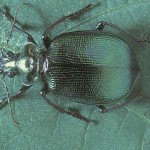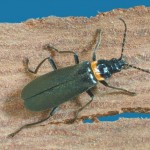Natural enemies of insect and mite pests are referred to as beneficials.
- Predators consume several-to-many prey over the course of their development. They are free living, and are usually as big as or bigger than their prey. Predators may be generalists, feeding on a wide variety of prey, or specialists, feeding on only one or a few closely related species.
- Parasitoids are similar to parasites, but where true parasites usually weaken but rarely kill their hosts, parasitoids always kill the host insect. In contrast to predators, parasitoids develop on or within a single host.
- Pathogens are diseases that attack pest insects. Pathogens of agricultural pests are usually bacterial, fungal or viral.
See also: Monitoring beneficials and Conserving or supplementing beneficials
Click on the image to enlarge.
| Beneficial |
Target pest | Specific symptoms/behaviour | Monitoring method | Habitat/field prevalence |
|---|---|---|---|---|
Ants |
Various small pests, caterpillar eggs, immature stages of some pests |
|
Direct search, visual | Old logs/ timbers. Populations reduced by inter-row cultivation or irrigation. Occur all year round |
Assassin bug |
Feed on many different pests – prefers soft bodied prey e.g. caterpillars and small bugs such as mirids. Nymphs can consume up to 160 small – medium larvae over a 10 week period | Approaches victims from behind, stabs with stylet-like mouthparts containing an enzyme which dissolves organs. Bugs suck these out – leave an empty shell of prey | Visual and sweep net | Found in crops, urban areas, coastal regions, forests and woodlands. Mainly in spring |
Bigeyed bug |
Predator of eggs of Helicoverpa and other species. Soft-bodied insects – whitefly and mites | Piercing and sucking mouthparts – feed on body fluids of prey. Can survive on nectar and honeydew when prey is scarce. | Visual and sweep net | Found in most crops. Mainly spring and summer. Numbers reduced by: insecticides, rainfall, high temperature and humidity |
Brown smudge bug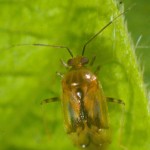 |
Feeds on Helicoverpa eggs, aphids, apple dimpling bug. Aggressive predator of mites | Piercing and sucking mouthparts – feed on body fluids of prey. | Visual and sweep net | Abundant in crops e.g. soybeans, lucerne, peanuts, sunflower. Spring and summer |
Damsel bug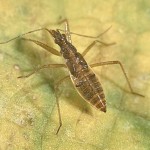 |
Feed on eggs and larvae, mites and aphids | Piercing and sucking mouthparts – feed on body fluids of prey. | Visual and sweep net | Found in most crops where caterpillars present. Adults – on weeds, winter crops and perennial crops. Mainly spring |
Earwigs |
Predator of all kinds of larvae, pupae and wireworms. Will attack Helicoverpa pupae in underground chambers | The common brown earwig is a nocturnal predator while the black earwig is a pest of seeds and seedlings | Visual searching – under logs, rocks, shelter traps | Widespread – found in most rural and urban areas |
| Green carab beetle | Hunts caterpillars and slow moving prey. Carab beetle larvae are predaceous but live in the soil. | Adults hide during the day and hunt at night | Shelter traps, night observation | Wide range of vegetation, urban areas, cropping and native vegetation. All year |
| Green soldier beetle | Adults feed on moths, larvae, Helicoverpa eggs. Soil dwelling larvae feed on soft bodies invertebrates | Can feed on leaves – have been known to feed on soybeans | Visual and sweep net | Mainly found in native vegetation – specifically eucalypts, also urban areas, cropping, forests |
Hover fly larvae |
Soft bodied insects – aphids, scale insects, thrips, caterpillars | Only larvae of hoverfly prey on pests. Adults feed on nectar and pollen | Visual and sweep net Beat sheet |
Various crops especially those infested with prey – especially aphids |
Brown lacewing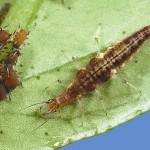 |
Active predators of soft bodied insects e.g. aphids. Also feed on Helicoverpa eggs | Differ from green lacewing by being longer, thinner and larvae do not camouflage themselves | Visual and sweep net Beat sheet |
Found in most habitats, common in urban areas with adults attracted to lights. Spring to autumn |
Green lacewing |
General predators – feed on thrips, mites, aphids, mealybugs , moth eggs and small caterpillars | Adults feed on nectar and pollen. Larvae camouflage themselves with remnants of dead prey which they place on their backs | Visual and sweep net Beat sheet |
Flowering vegetation will encourage green lacewings to stay in the landscape. Spring to autumn |
Ladybird beetles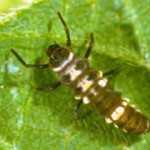 |
Important predator in most crops, early season. Voracious predators of aphids – may stop aphid populations from exploding. Also eats scale insects, mites, mealybugs, moth eggs and larvae, whitefly and jassids | Many types of ladybirds. The common spotted ladybird can consume up to 2400 aphids in her lifespan. | Visual search Sweep net Beat sheet |
Widespread distribution. Abundance often coincides with availability of the main food source of aphids and mites. All year round |
Pirate bug |
Thrips, mites, insect eggs and aphids | May also feed on pollen – most common when crops are flowering and when thrips are most abundant. | Visual and sweep net | Favour crops that produce flowers with pollen. Good flyers which assist with dispersal in the landscape. Spring to autumn |
| Parasitoids of aphids Lysiphlebus testaceipus Aphidius colemani 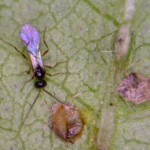 |
Aphids – parasitoids detect aphids through signals produced by aphid and infested plant | Female wasp inserts an egg into the aphid, developing larvae feeds inside aphid – killing it. Dead aphids take on a brown, swollen appearance – called a mummy | Visual and sweep net | Live in a wide range of crops – especially those infested with aphids, native vegetation and grassy habitats |
| Parasitoids of Lepidoteran (moths and butterflies) larvae Netelia producta Heteropelma scaposum Lissopimpla excelsa Microplitis demilitor Tachinid sp.- Flies 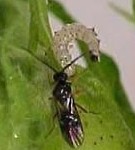 |
Larvae – e.g. Helicoverpa, armyworm | Wasps and parasitic flies (e.g. tachnid fly). Wasps sting young caterpillar (2nd-3rd instars) and lays eggs on or in larvae. Tachinid flies kills host through eggs laid on host or host consuming eggs and fly maggot burrows into host. | Visual and sweep net | Found in crops where prey is present as well as native vegetation and riparian vegetation |
| Parasitiods of pupae Banded caterpillar parasite Ichneumon promissorius Brachymeria sp. 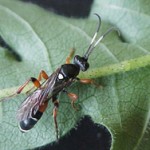 |
Specifically search for and parasitise moth pupae. Banded caterpillar parasitoid specifically target Helicoverpa and armyworm. Brachymeria is less specific with its prey. | Wasps locate and penetrate pupal chambers. Lays an egg in pupa and feeds of fluids from puncture wound. Host larvae dies and wasp larvae consumes tissues from pupal case. | Visual and sweep net | In crops where hosts are present and riparian native vegetation |
| Parasitiods of eggs Trichogramma pretiosum Trichogrammatoidea Bactra Telenomus 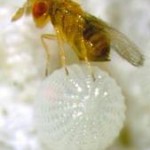 |
Wasps lay eggs on the eggs of caterpillars primarily Helicoverpa. Wasps emerge from eggs instead of larvae. | Kill hosts before they hatch thus prevent crop damage by larvae. Very small wasps and best way is to find the black parasitised eggs | Visual and sweep net | In crops and remnant native vegetation. They are greatly reduced in regions where broad spectrum insecticides are used regularly. Sorghum and maize are good nursery crops over summer while canola and faba beans are the best nursery crops over winter |
| Parasitoids of green vegetable bugs (GVB) Trichopoda giacomellii (fly) Trissolcus bassalis (wasp) 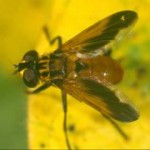 |
GVB eggs are parasitised by an introduced wasp. Mature and late instar GVB are parasitised by introduced fly. | Trissolcus female inserts eggs into GVB eggs. Parasitised eggs turn black. Trichopoda flies lay eggs on GVB body – these hatch and burrow into GVB – feeding on the internal organs and killing host. | Visual and sweep net | Parasitoids occur in all crops frequented by GVB |
| Parasitoids of whitefly Encarsia formosa Eretmocerus hayati  |
These wasps target different stages of whitefly development – making them complementary parasitoids | Encarsia lays eggs into 2nd, 3rd and 4th instar stages of whitefly. Wasp larvae feed inside and nymphs turn black. Eretmocerus lays eggs into 1st and 2nd instars and tiny larvae bores into whitefly and releases digestive enzymes when whitefly pupate – dissolving the pest. | Visual and sweep net | Found in crops as well as native vegetation |
| Predatory mites Amblyseius spp Phytoseiulus persimilis 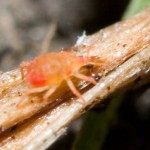 |
Two spotted mitesBean mites | They are voracious on all stages of spider mite. They can use the webbing made by spider mites to access their prey. They can detect kairomones emitted by prey and stay within infested areas or move to nearby infestations | Visual sampling Suction sampling Pitfall traps |
Crops with dense foliage in humid areas.Note – predatory mites can be purchased for the control of a variety of pests |
| Red and blue beetles Dicraolaius bellulus 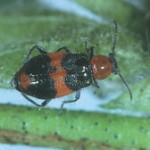 |
Eat eggs and small Helicoverpa larvae, aphids and slow moving insects. | Native predator | Visual Beat sheet sweep net |
Abundant in a range of habitats e.g. gardens bushland and crops. |
| Shield bugs Oechalia schellenbergii Cermatulus nassalis 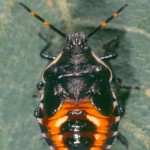 |
Prey on moth larvae e.g. Helicoverpa and loopers | Shield bug eggs are distinguished by the short spines (‘eyelashes’) around the rim of eggs | Visual Beat sheet |
Found on weeds, native vegetation and crops – especially those with moth larvae. All year |
| Silverfly Leucopis formosana |
Important predator of aphids. Adults feed on honeydew and are not predatory | Larvae look similar to hoverfly larvae and are distinguished by ‘two horns’ at rear of body. | Crops and weed hosts. Spring to autumn | |
| Predatory thrips Scolothrips sexmaculatus |
Generalist predators that fed on very small prey such as other thrips, mites and small eggs. | Feed by piercing the body and sucking out contents | Widespread and can be found feeding on mites in various crops and native vegetation | |
Hunting spiders |
Stalk or ambush their prey. They are generalist feeders and eat mirids, moth larvae and soft bodied insects | The most common hunting spider is the lynx spider | Visual sampling Suction sampling Pitfall traps |
Spiders are found in most urban and rural habitats. All year |
Web building spiders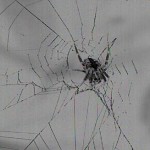 |
Generalist predators targeting a range of flying insect pests e.g. moths, mirids, jassids and whitefly. Many of these spiders will also eat Helicoverpa larvae | These spiders build large webs between plants and commonly hide under nearby leaves – waiting for insects to become trapped | Visual sampling Suction sampling Pitfall traps |
Bushland remnants are important habitats for these spiders in rural landscapes. All year |
| Viral Diseases Nuclear polyhedrosis (NPV) 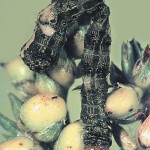 |
Moth larvae – NPV is specific for Helicoverpa | Larvae shrivel up. Most effective on small larva < 7mm | Visual sampling | Present in soil, disperses from infected larvae. Through spray applications. Note: efficacy is temperature dependant |
| Bacterial Diseases Bacillus thuringiensis (Bt)  |
Moth larvae | Most effective on small larva | Visual sampling | Through spray applications needed. Present in soil |
| Fungal diseases Metarhizium spp. Beauvaria spp. 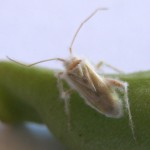 |
Moth larvae, aphids, mirids, grasshoppers. Some are species specific | Most effective on small larvae and nymphs | Visual sampling – look for fungus on bodies of pest | |
| Nematodes | Snails and some caterpillars | They enter the host body through natural openings and release bacteria that digest the insect. The nematode feeds on the bacteria and insect slurry | These tiny worm-like organisms can only be seen under a micrscope | Commercially produced nematodes are available in dehydrated cellulose mixtures – these are rehydrated before use |
